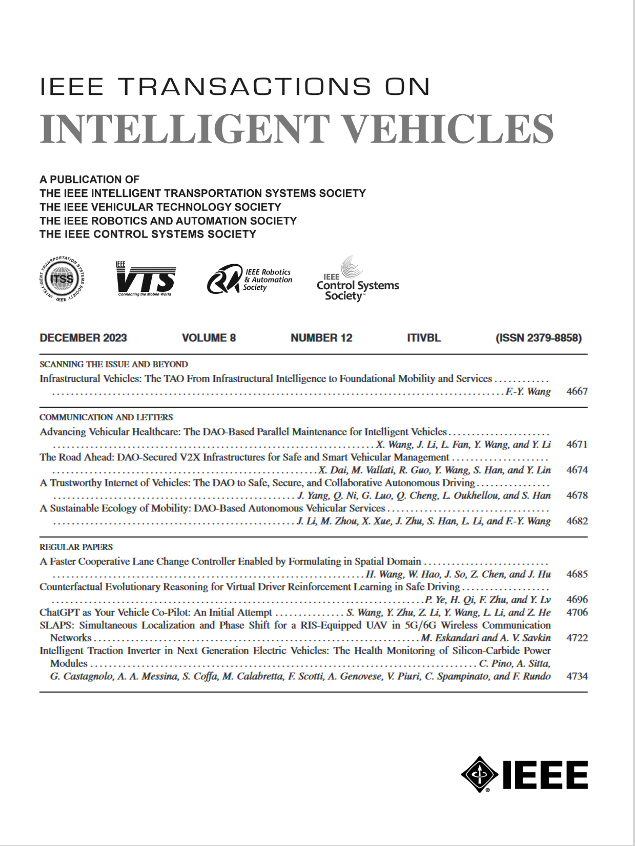基于FPGA的全景驾驶感知模型及推理加速
IF 14.3
1区 工程技术
Q1 COMPUTER SCIENCE, ARTIFICIAL INTELLIGENCE
引用次数: 0
摘要
全视感知系统对于自动驾驶至关重要,因为它们可以同时处理多个视觉任务,从而增强功能。与设计多个独立网络来处理各种任务相比,这些系统通过将各种任务集成到单个网络中来降低总体推理延迟。现有的全视感知网络通常依赖于预训练的分类模型作为其主干,这些模型不是针对特定任务量身定制的,从而影响了准确性。为了解决这个问题,我们提出了一个双分支主干和一个宽感知分割头,提高了网络在自动驾驶应用中的有效性。这种增强的网络可以同时进行车辆目标检测、可驾驶区域分割和车道分割。此外,为了满足自动驾驶严格的延迟要求,我们使用FPGA加速卡实现该网络。在我们使用具有挑战性的BDD100K数据集的实验中,该模型在所有任务的精度上都明显超过了基线。为了满足日益增长的实时性需求,使用了VCK5000 FPGA,其推理速度比基于gpu的部署快约35.2倍,能效约为41.5倍,在资源受限的场景中具有显著优势。本文章由计算机程序翻译,如有差异,请以英文原文为准。
Panoptic Driving Perception Model and Inference Acceleration Based on FPGA
Panoptic perception systems are critical for autonomous driving, as they process multiple visual tasks simultaneously, enhancing functionality. Compared with designing multiple independent networks to address various tasks, these systems exhibit reduced overall inference latency by integrating various tasks into a single network. Existing panoptic perception networks often rely on pre-trained classification models as their backbone, which are not tailored for specific tasks, thereby compromising accuracy. To address this, we propose a dual-branch backbone and a wide perception segmentation head, enhancing the effectiveness of the network for autonomous driving applications. This enhanced network can simultaneously perform vehicle object detection, drivable area segmentation, and lane segmentation. Furthermore, to meet the stringent latency requirements of autonomous driving, we implement this network using an FPGA acceleration card. In our experiments using the challenging BDD100K dataset, the model significantly surpasses the baseline in accuracy for all tasks. To satisfy the increased real-time demands, the VCK5000 FPGA is used, which achieves inference speeds approximately 35.2 times faster than GPU-based deployments and about 41.5 times energy efficiency, providing significant advantages in resource-constrained scenarios.
求助全文
通过发布文献求助,成功后即可免费获取论文全文。
去求助
来源期刊

IEEE Transactions on Intelligent Vehicles
Mathematics-Control and Optimization
CiteScore
12.10
自引率
13.40%
发文量
177
期刊介绍:
The IEEE Transactions on Intelligent Vehicles (T-IV) is a premier platform for publishing peer-reviewed articles that present innovative research concepts, application results, significant theoretical findings, and application case studies in the field of intelligent vehicles. With a particular emphasis on automated vehicles within roadway environments, T-IV aims to raise awareness of pressing research and application challenges.
Our focus is on providing critical information to the intelligent vehicle community, serving as a dissemination vehicle for IEEE ITS Society members and others interested in learning about the state-of-the-art developments and progress in research and applications related to intelligent vehicles. Join us in advancing knowledge and innovation in this dynamic field.
 求助内容:
求助内容: 应助结果提醒方式:
应助结果提醒方式:


